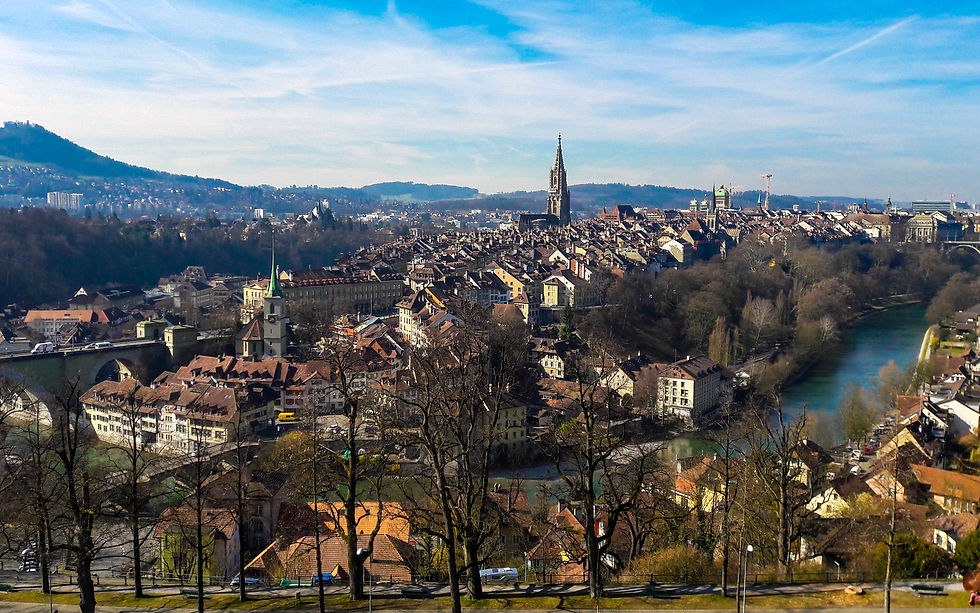10 REASONS WHY WE LOVED BERN
- Nick and Elen
- May 31, 2017
- 3 min read
Updated: Dec 28, 2018

So, let’s suppose you are planning a journey to Switzerland and would also like to include a few cities in your itinerary. Zurich and Geneva are probably the first if not the only cities which come to your mind. Right?
Well, may you allow us to tell you that the Swiss capital, Bern, shouldn’t be overlooked either . Surrounded by river Aare and built on a peninsula, Bern is beautiful as a postcard, especially when seen from above.
During our trip to Switzerland we visited Bern, while being based in Zurich, spent one day there and if we had to describe it in a few words, we would say that Bern is almost too pretty to be a capital.
So, with no further delay, here are the top 10 reason of why we loved Bern and why this city is worth visiting. 1. It’s built on a peninsula
Seriously, can you think of a more picturesque location ? The historical centre of Bern is built on a peninsula, surrounded by river Aare and looks like it has popped straight out of a fairytale.

2. UNESCO World Heritage Site
History, culture, geographical location and architecture are only some of the reasons why UNESCO has decided to include the historical centre of Bern to its world heritage sites' list and once you visit it, you will have no second thoughts about this decision.

3. It is the city of fountains
The old city of Bern counts more than 100 public fountains, most of which are crowned with 16th century statues. Apart from their decorative purpose, Bern's fountains are also an important source of clean, safe to drink water in the city.
P.S: This means you can have it for free, in a country where almost everything costs a small fortune!

4. It is also the city of bears
Bears can be spotted literally everywhere in Bern. From the canton's flag and the city's main clock tower (Zytglogge) to its buildings' facades and chocolate bites, bears almost rule Bern. Even the city's name may have derived from the word "bear"!
What's even more interesting though is that you can even see real, living bears in Bern. Located at the bottom of the Old Town, you'll find the Bear Pit (Bärengraben), where Finn, Ursina, Berna and Björk, 4 cute brown bears, live.

5. The Rosengarten
If you are anything like us and love viewpoints, then the Rosengarten is going to be your favourite place to visit, while in Bern.
It is one of the most beautiful public gardens in Bern, as well as a home to more than 200 rose varieties. The Rosengarten offers amazing views of both the Old Town and the Aare Loop.

6. Albert Einstein used to live here
Located on Kramgasse 49, inside the old town, you'll find the house which Einstein spent 2 years of his life in, from 1903 to 1905. The apartment has been restored in the style of that period and parts of Einstein's life and work are presented to the public. You can visit the apartment daily from 10am to 5pm for 6 CHF.

7. You can swim in the Aare river
Many European capitals are built on the banks of rivers but very few of them offer their residents and visitors the chance to swim in the river's waters. Bern is the exception and in the summer, you'll see hundreds of people swimming or doing water sports in the clean waters of Aare, so why not consider joining them?

8. Architecture
Most of Bern's buildings, located in the Old Town, date back to 18th century, while arches and arcades are also pretty common in the city. High Middle Ages and late Baroque styles are the main ones in Bern and make it look quite impressive to visitors' eyes.

9. The underground shops
Also part of Bern's architecture, the underground shops are maybe the most characteristic one too. Throughout the Old Town, you'll see multiple trap doors, which actually lead to "hidden" stores, boutiques, restaurants or even theatres and clubs.

10. It is home to Switzerland's largest church
Bern's cathedral happens to be the largest church in the country and offers amazing views of the city, if you choose to climb up its tower. Its construction lasted for a good 470 years and its figure holds a significant role in the city's architecture until today.




Comments